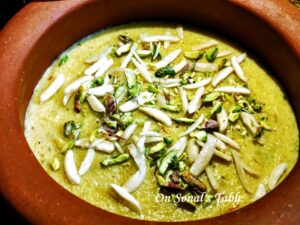The befitting end to any good meal is a scrumptious dessert. Wouldn’t you agree? And, the Phirni or chilled rice pudding is a gourmand’s delight. Any Indian food aficionado will tell you that it is one of the most satisfying ways to end a traditional Indian meal.
But, did you know that this dessert which is so widely eaten in India is not even Indian in origin? Although there is no hard evidence but it is believed that this scrumptious dessert originated in Persia or what we now call Middle East. It was brought to India by the Mughals. The kashmiris count this as one of their staple desserts. In taste it closely resembles its Indian cousins the ‘kheer’ and the ‘payasam’.
In Europe this dessert was introduced to cure stomach ailments or digestive disorders as it is light on the tummy and easy to digest.
Traditionally, the phirni is set to chill in the fridge in earthen bowls. The bowls absorb the excess moisture and help the sweet set to the perfect thickness.
Trust me, once you have tasted a spoonful of this delicious delicacy, you’ll be sure to lick your bowl dry.
This is my recipe for it.
PHIRNI (Rice pudding with almond and saffron)
INGREDIENTS
- 2 1/2 tbsp of rice (basmati or any other equivalent)
- 1 litre of full cream milk
- 1 tbsp warm milk (to dissolve the saffron)
- ½ cup sugar (granulated)
- 2 pinches of saffron + 1 pinch for garnish
- 1 tbsp blanched almond flour (or, paste of 8-10 blanched almonds)
- 7-8 almonds and pistachios, blanched and slivered for garnish (about 1 tbsp)
- 1 tsp rose water
- 2 pinches of nutmeg powder
- ¼ tsp cardamom seed powder
Note – If you do not have almond flour then you can grind 6-7 blanched almonds into a fine paste and add that.
Blanching almonds – soak almonds for about ½ hour in some hot water. After half hour the almonds will peel easily.
METHOD
- If you are not using almond flour then soak the almonds in warm water for half hour. After half hour, peel the almonds and grind about 8-10 of them into a fine paste. Halve the remaining ones and then cut them into slivers for garnish.
- In the 1 tbsp warm milk soak the saffron strands for about 10 minutes to allow the colour and flavour to infuse into the milk. Reserve 1 pinch for garnish.


- Soak the rice in warm water for about half hour.
- After half hour, discard the water and grind the rice into a coarse paste. The rice should be as coarse as grains of sand. You can also grind it into a fine paste, if you prefer that. But, I prefer a coarser texture.
- In a heavy bottomed pan, heat the full cream milk. Stir occasionally so that it does not stick to the bottom of the pan. The idea is to reduce it till it thickens.
- Once the milk is reduced to half its original volume, add the coarse rice paste and almond paste/almond flour. Continue to keep cooking on a low flame, stirring all the time. The rice tends to form lumps in the hot milk so stir continually so that no lumps are formed.
- Once the rice is cooked completely, add the saffron induced milk and the sugar.
- Continue stirring till the mixture is thick and creamy.
- Add the nutmeg and cardamom seed powder and stir in the rose water.
- Take off the heat and cool.
- Once cooled, pour into an earthen (or any other) bowl, cover and keep in the fridge to chill for at least 2-3 hours
-


- Garnish with slivered almonds, saffron strands and slivered pistachios before serving.

 Sonal Singh On Sonal's Table
Sonal Singh On Sonal's Table




